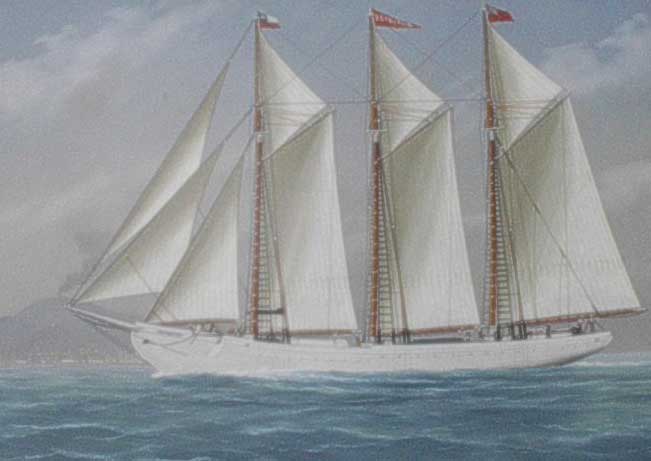
Captain Sinclair
unofficially still holds the fastest sailing record between St. John's and
Belize, British Honduras, 26 days down and back, set in the Retraction in
1924.
On the return from Cadiz with a load of salt, the Retraction
suffered heavy weather and was abandoned about 1000 miles south of Cape Race.
His crew included his brother Max, as Mate; Seamen Abner Brennan, Samuel Chapland and Max House; and
Cook S. Steeds. Rescued by a British oil tanker S.S. El Oso and taken to Curaco
in the British West Indies, they were returned to New York on S.S. St. Agnes and
from there to St.
John's on the Red Cross liner Rosalind.
The first duty of a captain of a lost vessel, upon rescue, is to make a formal declaration of the incident. This facsimile is of a carbon copy typescript provided by the radio operator of the S.S. El Oso to Captain Sinclair. For 12 days he and his crew battled against the "perfect storm" of
1926. Privately he claimed he always knew the Retraction was "weak in the
keel" and blamed this fault on her eventual demise. His daughter Nina Marie
was born on February 2 at Devon House, Duckworth Street, then the Templeman
family home, where his family had taken refuge while awaiting news of the ship's
fate as it was long overdue. He arrived back in St. John's on March 14.
The facsimile repeats original spelling mistakes. Click
here to see scan of original document.
|
FEBRUARY 6 th 1926 ON BOARD S.S. "El Oso" This is to certify that I, John Sinclair, Master of the British Schooner "Retraction" of 148 tons nett, owned by Philip Templeman of St. John's, Newfoundalnd, make the following declaration:- On the 31st day of December 1925, I sailed from Cadiz, Spain, with a cargo of salt bound for Catalina, Newfoundland, passage was made south of the Azores and fair weather was met during the voyage until January 23rd 1926, weather was gradually getting bad, with high seas and strong gales in North Westerly direction. It was now found that vessel was making a little water, and this was pumped every hour. Wind and Sea continued to rise until January 28, when a strong gale was blowing from South West, increasing, and veering to West North west, during which time, the pumps were more and more necessary. January 29th. Vessel was now in Lat. 41-30 N Long. 48.01 W. Wind increasing to storm, vessel laying to starboard tack, very heavy weather at 10 p.M. sea breaking on vessel, smashing lifeboat in chocks, and causing deck to start. Pumps were now manned continuously. About 11.30 P.M. Sea broke on vessel causing her to go astern and rudder gave a sharp crack. Noticed it was lifted about two inches and causing it to beat from side to side, heaving reason to think that the top pintle was broken. Water coming in through rudder case in different places. Unable to keep rudder quiet by lashing wheel was compelled to keep vessel before wind and sea. vessel had now started to leak badly. January 30th. Very high sea and storm of wind, vessel running with oil bags out to starboard and port bows, shipping heavy seas fore and aft, beat off several pieces of bulwarks to free decks. Was necessary to lash men to wheel and pumps to enable them to continue their duties. January 31st. Wind veering more North with strong gale, vessel running in South easterly direction. February 1st. Wind moderating. At 8 a/m tried to lay vessel to, but finding rudder beating so badly was compelled to keep vessel before wind and sea, as rudder appeared as if it would cause more damage. Vessel was now getting strained everywhere as oakum was coming out of seams fore and aft, also out of stern boards. Scarfs in rails were open, covering boards open, also butts in deck, and leaking badly. Salt going out of fore hatch. Vessel leaking about 700 strokes of pump per hour. February 3rd. Decided to abandon vessel if any other ship came in sight, in mean time try to work vessel south into fine weather. February 4th. Vessel reaching South with storm sail and two reefed mainsails, whole foresail and jumbo, making very little progress. Rudder working badly, from side to side, spars working in deack about two inches, bowsprit working badly in bollards. About twentyfive tons of salt gone out of midship part of vessel, mostly on starboard side causing vessel to list to port. About 10.50 sighted a light to leward, flares were made and vessel altered course and came towards us, proved to be the S.S. "El Oso". After calling out to the Captain telling him I want to abandon vesel and had no lifeboat. A boat was sent from the above vessel which took us of about 12.30A.M. Before leaving vessel I set fire to her fore and aft. Position Lat.33.06 N. Long 39.19W. After getting on board the S.S."El Oso" the lifeboat was abandoned owing to heavy sea, and personal effects of Master and crew, including Official Log Book were lost. When last seen the Schooner "Retraction" was ablaze and had a heavy port list. Master "Retraction" |